Originally published in The Clarinet 46/3 (June 2019). Printed copies of The Clarinet are available for ICA members. 
Music Reviews
STUDIES AND WORKS FOR SOLO CLARINET
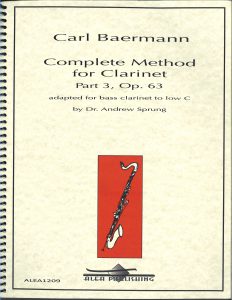 Carl Baermann. Complete Method for Clarinet, Part 3, Op. 63. Arranged by Andrew Sprung. Alea Publishing, 2018 $20.00
Carl Baermann. Complete Method for Clarinet, Part 3, Op. 63. Arranged by Andrew Sprung. Alea Publishing, 2018 $20.00
Carl Baermann’s Complete Method for Clarinet, Part 3, Op. 63, is a nearly indispensable study for all clarinetists. This edition by Andrew Sprung is a reorganization and expansion of Baermann’s classic method to fit the bass clarinet with extended range to low C. Sprung is not the first to release such an adaptation. His edition draws parallels to an earlier release by Jack Snavely, former professor of clarinet at the University of Wisconsin-Milwaukee. In a similar fashion to the Snavely edition, Sprung reorganizes the major and minor scale and arpeggio exercises by key, advancing through the order of sharps and flats. The bulk of the book contains scale patterns including arpeggios, interrupted scales, broken chords, returning scales, dominant 7th chords, thirds and sixths. In the back of the book, Sprung also includes exercises on chromatic, octatonic and whole-tone scales as well as augmented and fully diminished seventh chords. While Sprung’s reorganization of the Baermann method is a convenient feature, the true value of this edition comes from the use of the full range of the bass clarinet to low C. Every exercise makes use of the lowest notes to some extent. Sprung opts not to include articulations, instead giving instructions for the performer to “choose articulations (in consultation with a teacher when applicable) based on their individual goals.” Those wishing to incorporate the extended range of the bass clarinet into their daily scale study may find this edition beneficial.
– Zachary Dierickx
 Ivane Béatrice Bellocq. Triptyque for clarinet solo. Gérard Billaudot, 2018. $12.99
Ivane Béatrice Bellocq. Triptyque for clarinet solo. Gérard Billaudot, 2018. $12.99
French composer and flutist Ivane Béatrice Bellocq (b. 1958) wrote this three-movement work (“Prelude,” “Incantation” and “Danse”) in 1978 for Serge Daval. Jean-Marc Fessard was the clarinetist in the portrait recording of Bellocq’s works on the DUX label. “Prelude” juxtaposes melodic/harmonic ideas based on pitch centers, with careful attention to expressive dynamics, against quarter-tone inflections and whimsical twittering reminiscent of Messiaen’s bird-centric melodies. The repeated pitches of “Incantation” and unwavering forte senza diminuendo marking give the slow legato lines a solemnity of expression. “Danse” provides relief from the intense nature of the preceding movements with repeated rhythmic patterns and mixed meter ideas while staying in Bellocq’s modernistic atonal sound world. This medium-difficult work contains one very full (and not difficult) multiphonic.
– Gregory Barrett
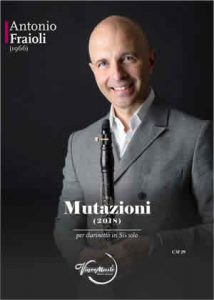 Antonio Fraioli. Mutazioni for solo clarinet. VigorMusic, 2018. €10.00
Antonio Fraioli. Mutazioni for solo clarinet. VigorMusic, 2018. €10.00
Antonio Fraioli continues his well-earned status as a favorite composer/clarinetist with this sparkling 4’30” solo clarinet work. Written for Domenico Calia – and perhaps a reflection of his preferences and ability – Mutazioni is a concise and highly organized advanced work that is a catalog of the many things clarinetists like most to do. Slow quiet phrases on our lowest notes, return of the same melody two octaves higher or lower, rapid passage work that lays well in our hands… Fraioli gives us all of that plus glissandi, flutter tongue, slap tongue and simultaneous singing and playing. What could be better? The answer is beautiful engraving on the printed page, high quality paper and a glossy cover with Professor Fraioli smiling his encouragement at us.
– Gregory Barrett
 Christopher Wiggins. Solitudes for Solo Clarinet, Op. 113a. C.D. Wiggins, 2016. $8.20
Christopher Wiggins. Solitudes for Solo Clarinet, Op. 113a. C.D. Wiggins, 2016. $8.20
Solitudes, Op. 113a, is a work for unaccompanied clarinet. The piece is marked Poco Lento (senza misura) and contains no time signature. The opening G to B-flat interval acts as a recurring motive as the piece gradually repeats and expands upon it. Wiggins makes careful use of silence and large dynamic shifts throughout the piece. The lack of time signature and contrasts in dynamic make the piece interesting. It could be a good work for intermediate students when first approaching the unaccompanied solo medium.
– Zachary Dierickx
WORKS FOR CLARINET AND PIANO
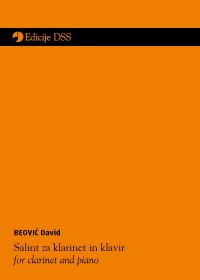 David Beovič. Salint for clarinet and piano. Edicije DSS, 2017. www.dss.si €10.95
David Beovič. Salint for clarinet and piano. Edicije DSS, 2017. www.dss.si €10.95
Written in 2016, David Beovič’s Salint adds to the repertoire a delightful three-movement work for clarinet and piano. A Slovenian composer, Beovič (b.1977) wrote Salint for Duo Claripiano: clarinetist Dušan Sodja and pianist Tatjana Kaučič. Beovič himself studied clarinet and piano in Žiri before beginning his composition studies in Ljubljana, and his first-hand knowledge of the instruments yields an idiomatic and well-integrated 10 minutes of chamber music.
Beovič composes across genres including incidental music, film scores, computer game scores and others. Though rooted in his more serious “classical” language, Salint reveals this commercial influence, not unlike the work of Robert Muczynski. A quote from Beovič’s young son Max precedes each of the three movements, revealing a dry sense of humor (“Ati, if Jesus was born earlier, would you be afraid of dinosaurs?”). Indeed, levity pervades the musical texture, and audiences will find this piece immediately accessible and enjoyable, despite moments of well-judged dissonance.
Beovič shows restraint in his technical demands. Salint is moderately difficult, with some quick articulations, wide interval leaps and some less-familiar scales, but it does not require the clarinetist to venture above the fifth partial, nor does it require any extended techniques. Students and professionals alike will enjoy learning and performing Salint.
– Matthew Nelson
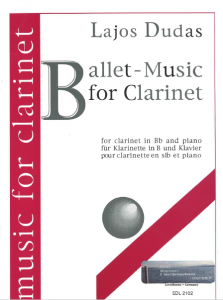 Lajos Dudás. Ballet-Music for Clarinet. Edition Darok, 1993. $14.95
Lajos Dudás. Ballet-Music for Clarinet. Edition Darok, 1993. $14.95
Hungarian clarinetist and composer Lajos Dudás was born in 1941. He attended the Béla Bartók Conservatory and the Franz Liszt Academy of Music, and taught at the Neuss School of Music in Germany and the Rheinland College of Education. Though best known in the jazz world, he has also been featured as a classical soloist. His career is difficult to categorize, as it includes not only jazz and classical, but also avant-garde chamber music and his own arrangements of the music of J.S. Bach. Additional compositions of interest include Concertino for Clarinet (“Homage to Artie Shaw”) and a two-volume clarinet method.
This four-movement work for clarinet and piano is about 7 minutes and 30 seconds in length. Though this published version is completely notated and there is no need to improvise, a recording with the Lajos Dudás Quartet contains several spots where the clarinetist does improvise. If you are one of the rare classical clarinetists who can improvise, here is your chance!
The main difficulty in this piece is that many of the fast technical or rhythmically complex passages must line up exactly between clarinet and piano. Given that three of the movements are written at a fast tempo, it will take a considerable amount of rehearsing and musical maturity from both players in order to have precision in ensemble but also retain the laid-back jazz feel.
– Robyn Jones
 Theodor Baron von Schacht. 3 Clarinet Concertos for Clarinet in A and Orchestra arr. for clarinet and piano. Nico Bertelli Edition, 2017. www.nicobertelli-clarinet.com €18.00 each for PDF.
Theodor Baron von Schacht. 3 Clarinet Concertos for Clarinet in A and Orchestra arr. for clarinet and piano. Nico Bertelli Edition, 2017. www.nicobertelli-clarinet.com €18.00 each for PDF.
Theodor Baron von Schacht (1748-1823), pupil of Niccolò Jommelli, was a highly acclaimed Kapellmeister at the Court of Thurn and Taxis in Regensburg, Germany, where clarinetist Joseph Schierll performed. This was probably the reason von Schacht dedicated to him a good number of clarinet concertos; in fact he wrote 12! Only a few historic composers wrote a large number of clarinet concertos, such as Carl Stamitz (12), Michel Yost (14) and Johann Molter (6, for D clarinet). The peculiarity of von Schacht’s concertos is that four of them are for A clarinet, a size not much used at those times as a solo instrument. This changed with the well-known Mozart compositions K. 581 and K. 622. Other early works with A clarinet are Michael Haydn’s Serenade in D Major and Joseph Purebl’s Clarinet Concerto. One of the four von Schacht concertos, probably the most demanding one, in A major, was previously published by Kunzelmann in 1995. All of them are preserved at the Taxissche Hofbibliothek in Regensburg. The three concertos in Nico Bertelli’s editions (B minor and two in D major – all for A clarinet) are quite easy – simple, pleasant music, structured in three movements, with short Adagios and in one case a Minuet last movement. One of them has a key signature of four flats. This is unusual considering the four- or five-key clarinet used at those times! Nico Bertelli, great chalumeau scholar, has in his online catalog many other little rare gems including works for chalumeau, clarinet concertos and arias with clarinet as obbligato instrument. I would highly recommend to visit it!
– Luigi Magistrelli
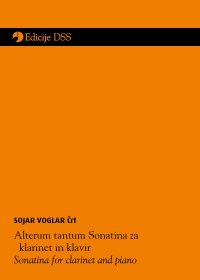 Črt Sojar Voglar. Alterum tantum: Sonatina for clarinet and piano. Edicije DSS, 2017. www.dss.si €12.00
Črt Sojar Voglar. Alterum tantum: Sonatina for clarinet and piano. Edicije DSS, 2017. www.dss.si €12.00
The outstanding Slovenian composer Črt Sojar Voglar (b. 1976) has written several hundred concerto, orchestral, vocal and chamber works for a dizzying array of featured instruments. Alterum tantum was composed in 2013 for Duo Claripiano of Dušan Sodja, clarinet and Tatjana Kaučič, piano. You can find their recording from the 2014 premiere in Maribor, Slovenia on Voglar’s website.
Voglar writes in an appealing style well-informed by his 20th century beacons: Messiaen, Lutosławski and the Finns, Einojuhani Rautavaara and Magnus Lindberg. The subtitle Sonatina belies the impact of this work, which is far from inconsequential. Voglar has created a 14’30” sound and emotional landscape that neatly divides into four continuous sections. The first begins tranquillo with low-register solo clarinet joined by a gentle arpeggiation from the greatest depths of the piano. The pitch choices are immediately compelling and encyclopedic. Are we entering a world of mysticism, progressive harmonic innovation or even one with jazz and pop music connotations? The upward-arching lines become more insistent and the subtle polytonality caresses until the mood of the opening returns in varied form. A scherzo-like Allegro derives from the final unison of the first section. Chock-full of repeated notes, syncopated figures and intervals concentrating on seconds and thirds, the music suddenly takes a new direction with playful tempo modulations from one measure to the next. By way of tremolos and trills in the piano and bisbigliando (timbral) trills in the clarinet, the third section, beginning tempo ad libitum, is reached. The materials of the first parts are transformed to highlight their expressive qualities. Another harmonically consonant transition makes the bridge into the concluding section, Allegro vivace. Fleet-moving, syncopated melodic lines are boldened by cross-rhythms between the clarinet and piano. Just as the clarinet part becomes more lyrical Voglar again introduces a tempo-modulation quickening the pace. The elements of arpeggio, trill and syncopation combine, leading to a cadence with a sustained fermata in the clarinet alone. This note leads to an innocent semplice episode of repose before all the jubilant elements return. I won’t ruin the surprise of the ending.
– Gregory Barrett
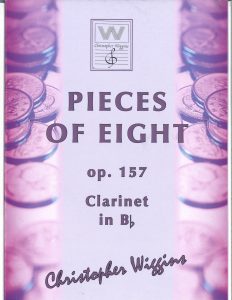 Christopher Wiggins. Pieces of Eight, Op. 157. C. D. Wiggins, 2009. $19.90
Christopher Wiggins. Pieces of Eight, Op. 157. C. D. Wiggins, 2009. $19.90
Pieces of Eight, Op. 157, is a set of eight short movements for clarinet and piano. Each movement uses a distinct tempo and style reflecting its descriptive title: “Praeludium” (Hommage à Béla Bartók), “Berceuse,” “Gavotte,” “Valse,” “Lullaby,” “Czárdás,” “Carol” and “Reflections.” The piece is written with a conservative range – it does not extend into the altissimo register at all – and is relatively easy and straightforward
to perform.
– Zachary Dierickx
WORKS FOR TWO CLARINETS AND FOR FLUTE AND CLARINET
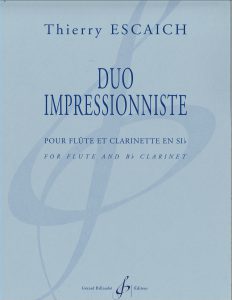 Thierry Escaich. Duo Impressionniste for flute and B-flat clarinet. Gérard Billaudot, 2018. $10.99
Thierry Escaich. Duo Impressionniste for flute and B-flat clarinet. Gérard Billaudot, 2018. $10.99
Works by Thierry Escaich have been examined in previous columns and it is a pleasure to become acquainted with another no matter how brief, in this case about 75 seconds. This easy-medium duet features dovetailing mini-phrases of five to 16 legato 16th notes. Most begin with a syncopated entrance enhancing the feeling of forward momentum. The range of both the flute and clarinet is modest and the greatest metric challenge is a few measures of 7/16 at the joyous climax. The subtle charm of this Andante work is due to the bittersweet, breezy, passing intervals between the two instruments. Thirds abound, and then a major second on a strong beat. Octaves and unisons are as much a surprise as a minor second. Not at all reaching a strong polytonality as used by Darius Milhaud, though a hint of him is in the air, Escaich has captured happy and sad in good balance.
– Gregory Barrett
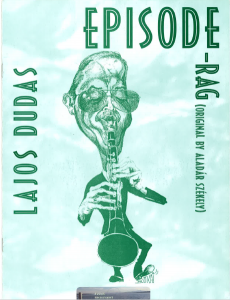
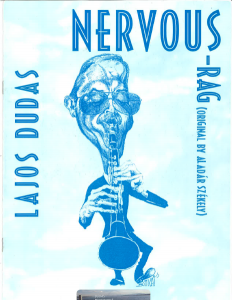 Aladár Székely. Nervous-Rag. Arranged for two clarinets by Lajos Dudás. Edition Neuma, 2007. €7.90
Aladár Székely. Nervous-Rag. Arranged for two clarinets by Lajos Dudás. Edition Neuma, 2007. €7.90
_____. Episode-Rag. Arranged for two clarinets by Lajos Dudás. Edition Neuma, 2007. €7.90
Episode-Rag and Nervous-Rag are arrangements based on original music by Aladár Székely. There are many similarities between the two short pieces. Both are for two B-flat clarinets and are less than two minutes. They are published in score format with a part (score) for each player. Each piece has the same upbeat tempo with only a moderate level of difficulty, and could be played by a college or even advanced high school student. The biggest difficulties for a student performance would be style and security with the syncopated rhythms that are common in this music. Either of these would make a great encore piece on a recital or would be a pleasant addition to sight-reading material in lessons.
– Robyn Jones
Christopher Wiggins. Suite for Two. C. D. Wiggins, 2016. $14.75
 Christopher Wiggins (b. 1956) is a British composer with a large output of choral, chamber, orchestral, solo and educational pieces. His Suite for Two is a five-movement duet for two clarinets containing “Czech Dance,” “Lament,” “March,” “Berceuse” and “Bourrée.” Each movement is short and somewhat predictable, but nonetheless enjoyable to play. These are well suited for teachers looking for good sight reading material for their younger students.
Christopher Wiggins (b. 1956) is a British composer with a large output of choral, chamber, orchestral, solo and educational pieces. His Suite for Two is a five-movement duet for two clarinets containing “Czech Dance,” “Lament,” “March,” “Berceuse” and “Bourrée.” Each movement is short and somewhat predictable, but nonetheless enjoyable to play. These are well suited for teachers looking for good sight reading material for their younger students.
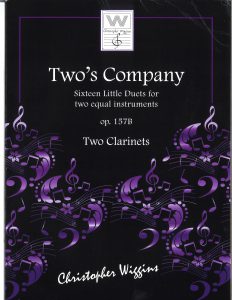 _____. Two’s Company: Sixteen Little Duets for two equal instruments, Op. 157b. C.D. Wiggins, 2013. $22.00
_____. Two’s Company: Sixteen Little Duets for two equal instruments, Op. 157b. C.D. Wiggins, 2013. $22.00
In a similar vein, Two’s Company (Op. 157b) contains 16 short duets with descriptive titles including “Steppin’ Out,” “On The Seashore,” “Slumber Song” and “Carousel” among others. Although each duet is set in G major, they still contrast in tempo and style. This collection of duets is also available in an edition transposed for flute (or oboe) and clarinet.
Christopher Wiggins has other works available for clarinetists including Eight for a Start (for clarinet duet with piano as well as flute/oboe and clarinet duet), Three of a Kind (B-flat clarinet quartet, also available as a flexible quartet with transposed C
and B-flat parts) and Nocturne (for clarinet and piano).
– Zachary Dierickx
WORKS FOR FOUR OR MORE PERFORMERS
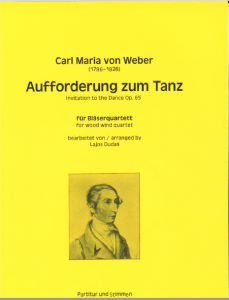 Carl Maria von Weber. Invitation to the Dance, Op. 65. Arranged for woodwind quartet by Lajos Dudás. Edition Dohr, 2016. €15.80
Carl Maria von Weber. Invitation to the Dance, Op. 65. Arranged for woodwind quartet by Lajos Dudás. Edition Dohr, 2016. €15.80
Weber composed this spirited waltz in 1819 for piano solo and Berlioz orchestrated it in 1841. Dudás arranged his version for flute, oboe, clarinet and bassoon, and it is a welcome addition to the repertoire for this combination of instruments.
To attain a performance that has the same effect as the original version, one will need to adjust the tempos that are indicated in this arrangement. The only metronome marking provided (quarter = 152) is too fast for the opening, which programmatically is the invitation to dance and should feel more like a tentative question and answer. Following the slow introduction the dance begins, and the tempo is typically in the range of dotted half = 84. This tempo will achieve the desired joyous waltz quality, but will provide a challenge in that the running eighth notes that are played by one pianist in the original are now passed between instruments. This arrangement is shorter than the original and ends with a flourish instead of a return to the slower “moderato” tempo. Four parts and a score are included.
– Robyn Jones
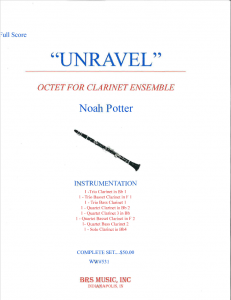 Noah Potter. Unravel for clarinet octet. BRS Music, 2018. Duration: c.10’ 05” $50.00
Noah Potter. Unravel for clarinet octet. BRS Music, 2018. Duration: c.10’ 05” $50.00
Noah Potter began piano at age 4 and composed his first piece at 8. Ragtime was his early choice of music. His early training included study with the late Arlene Sagan in Berkeley. He later studied with Easley Blackwood and John Eaton at the University of Chicago. In addition to his works for concert stage, he is an award-winning film composer and songwriter. He has written for feature film directors from Hollywood to Bollywood, with international clients that include HBO, NBC and others.
A few notes about the piece from the composer:
I conceived Unravel as a dance piece, with musicians and dancers sharing the stage. As such, the ensemble is broken into groups of one, three and four instruments across the stage; the sub-ensembles are part dynamic “scenery” such that the form and arrangement of the piece creates spaces for dance performance.
Rose Sperrazza, clarinet professor at Northeastern Illinois University, adds further information about the piece:
Unravel was composed for an event that I organized at Northeastern Illinois University and it was a collaboration between the Chicago Clarinet Ensemble, Novacane Clarinet Quartet, and the dance and creative writing departments at Northeastern Illinois University. While we were specifically interested in the collaboration between art forms, the work can also be performed without dancers and writers.
The YouTube video, with clarinet soloist Eric Mandat, does not include the creative writers because it would have been too long.
Unravel is a complex and intriguing composition. I find the interplay between the dancers and the clarinets to be fascinating. The solo clarinet part is difficult but the other parts are manageable; much of the time they have rests or perform repeating patterns. Perhaps this is a touch of minimalism as it occurs in many sections. The piece begins with the “trio group” with all players using a measured vibrato producing a throbbing affect. This is followed by the entrance of the “quartet group” playing a contrasting section before the solo clarinet enters. The mostly quartal harmony is not dissonant, but there are a few tone clusters with semitones that provide a harsh, grating dissonance. Several times there is a reference to jazz, with syncopation and bluesy runs. There is a long solo for one of the bass clarinets.
The “trio part” and the “quartet part” both require basset horns in F (note the composer lists these instruments as “basset clarinets”). Also, the two bass clarinet parts extend to a low D. Potter uses these low register notes many times and they are a very effective and integral part of this work. He provides helpful performance suggestions. The score and parts are carefully marked with articulations, dynamics and phrasings.
This work should provide an unusual aural and visual experience for any audience. Highly recommended!
– Robert Chesebro
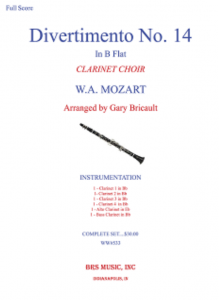 Divertimento No. 14 in B-flat major, K. 270. Arranged for clarinet choir by Gary Bricault. BRS Music, 2018. Duration: c. 11’ 40” $30.00
Divertimento No. 14 in B-flat major, K. 270. Arranged for clarinet choir by Gary Bricault. BRS Music, 2018. Duration: c. 11’ 40” $30.00
Arranger Gary Bricault has been composing and arranging music for many years. He considers music to be a serious avocation and has worked in diverse mediums including woodwind, brass, string and wind band. Even though he is an engineer by profession, he has been prolific. His web page lists a plethora of works. On the back cover of this score the full page is needed to list his clarinet choir arrangements.
Mozart’s Divertimento No. 14 is likely known to many woodwind players. He composed it in 1777 while living in Salzburg. It was originally scored for pairs of oboes, horns and bassoons but has been arranged for other ensembles, notably woodwind quintet in arrangements by Anthony Baines and Alan Civil. Another woodwind quintet version of the first movement appears in a collection published by Rubank.
Bricault’s arrangement of all four movements is scored for clarinet choir of four B-flat clarinets, alto clarinet in E-flat and bass clarinet. Neither of the contrabass clarinets are included in this edition.
The composer indicates the level of difficulty as a five out of six. However, the brunt of the difficulty is found in the first and second clarinets and in the alto clarinet. The parts and score are clear, easy to read, and the articulations and phrase markings are carefully indicated.
The four movements are typical of many of Mozart’s works. Movement I is an Allegro molto in sonata form. The second movement is a delightful Andantino almost in the style of a dance. Movement III is a charming Menuetto and Trio. The finale is a brisk Rondo marked Presto. Although the duration of this work is almost 12 minutes, the arranger lists a timing of 6’46’’ if no repeats are taken.
This work should be fun to play. It would work well for college students or other clarinet ensembles. It is light, capricious and should be a delight to any audience.
– Robert Chesebro
 Antonio Fraioli. ClariPercussions for solo clarinet, clarinet quartet (with bass clarinet) and percussion ensemble. VigorMusic, 2018. €45.00
Antonio Fraioli. ClariPercussions for solo clarinet, clarinet quartet (with bass clarinet) and percussion ensemble. VigorMusic, 2018. €45.00
ClariPercussions was written for soloist Paolo Beltramini, the Stark Quartet and the University of Central Florida Percussion Ensemble for the premiere at ClarinetFest® 2017. This fun, three-movement, 13-minute work is of medium difficulty except for several rapid scale passages in the solo clarinet. The clarinetists and percussionists (at least four players to cover the eight provided parts) are mostly unified in musical material – they do not perform in opposition to each other. A light jazz approach fits the work, especially the concluding movement, “Swinging.” The inventive rhythmic body percussion (for all performers) in the last movement is in balance to the rhythmic, repeated-note ostinatos of the first movement “Meeting.” Movement II, “Dreaming,” features the two vibraphones, marimba and drum set supporting the solo clarinet’s unhurried amblings. Look for the ClarinetFest® video on YouTube.
– Gregory Barrett
Comments are closed.